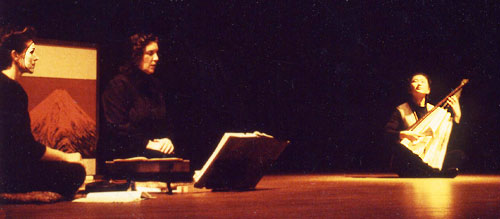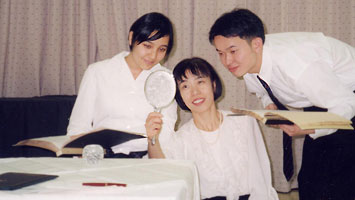BAFA © 2010. All material here is copyrighted. See conditions above. |
Janet Sono
theatre, Japan.
|

Janet Sono, 2003.
|
I was born into a musical family in Nebraska, U.S.A. in 1946.
I performed in my first play in 1961, then went on to major in theatre at the University of Kansas. With sights set on becoming a professional actress, I journeyed to New York City in 1969. The Fates, however, led me to Japan in 1970, where I have lived ever since. I am currently associate professor at Doshisha Women's College in Kyoto, where I teach courses in theatre, film, and performance, directing a full-length production nearly every year.
In the late 1980s, I discovered a latent interest in playwriting and have six published plays to date. My husband and I have two sons.
In retrospect, I would say my training as a playwright started the day I mounted the stage to play my first major role. It was as "Toinette" in Moliere's The Imaginary Invalid. I was a fifteen-year-old star-struck high school student. As everyone knows, the most important person in a play-in-production is the director, because they bring everything together.
|
The director looks at the small acting bits as well as the larger stage picture that includes set, lighting, costumes, and sight lines. In those formative years (1961-1970), I managed to get cast in an amazing number of plays and musicals in high school, college, and summer stock theaters. The theatre was home to me. I really felt that I belonged. I loved the repartee between director and actor, between actor and actor. I was also blessed with kind and gifted directors whose direction inspired me later when I myself became a director (1975-present).
The first major production I directed was for an English-speaking society of thespians in Kyoto, Japan. The play was The Fantasticks, a musical. Somehow, as I directed these eager and talented young college students it seemed like virtually everything every director had ever said to me came back to me. In 1984, I directed my first Shakespearean play, which, like the musicals, was an enormous undertaking. To date, I have directed ten all-women Shakespeare productions at my college.
|

A Scene from The Taming of the Shrew, 1996, directed by Janet Sono, Japan.
| When I sat down to write my first play in 1988, it was William Shakespeare who was whispering in my ear. Everything about a Shakespearean play is a challenge and a lesson. I learned how to write plays by directing Shakespeare. For me, he is the master. The way he structures his plays, the way he introduces characters, the amazing plots he devises. Nearly every comedy, for example, has three sometimes totally unrelated plot lines which he brings logically together, tying up all the loose strings in Act V.
Also, his comedies always have three happy, newly wedded couples to grace the stage at the end of the play (As You Like It, The Taming of the Shrew, A Midsummer Night's Dream, Twelfth Night, The Merchant of Venice).
Although I don't pretend to come anywhere close to Shakespeare, I do always have his plays in the back of my mind when I write. The touches of music and dance, the frequent use of a narrator, the wonderful characters, the complicated plots, the simple settings, the emphasis on properties, and, of course, the heavenly language.
When it comes to dialog, I'd say I've been influenced by all the plays I have ever read. I like to have some fairly quick dialog interspersed with more lengthy speeches. The style depends on the play. And, although Shakespeare's poetry rings in my ears, I do not write my plays in verse form. When it comes to stage directions, I have always been enamored of the stage directions of Tennessee Williams. I started out my very first play, Desiree's Baby, an adaptation of the Kate Chopin short story, emulating his style, and have continued doing so to this day.
|
As I have lived and worked in Japan since 1970, I studied Noh Theatre as a performer for several years, seen countless Noh, Kyogen, Kabuki, and Bunraku plays as well as Nihon Buyo and Butoh (Japanese dance), it is only natural that this genre would have a great influence on my plays, both as a director and as a playwright. And so. Whispering in my ear, or in my mind's eye, I see these techniques from Theatre Japan and often purposely, often unconsciously, incorporate them into my plays in one form or another. I am especially fond of kurokko(the "unseen" man dressed all in black who surreptitiously hands properties to the actor, or helps with an onstage costume adjustment).
Lastly, as a Bahá´í, I would have to say that an article I read in Bahá´í Etudes in the 1980s has had a tremendous influence on me as a playwright. Essentially, the author emphasizes the mysterious power of prayer as an inspiration to the artist. Before every writing session, I clear the air, clear the space, face my Maker and pray for guidance. Of course, for me, this is the most important part of the creative process.
|
|
During the writing of the Kate Chopin adaptations, I looked back at all of my favorite Lafcadio Hearn (1850-1904) books and started studying him in earnest. My interest in Hearn mainly stems from his insightful writings on Japan. He arrived in this country as a journalist with the Atlantic Monthly in 1890 but found the country so enchanting that he stayed on, married a Japanese woman with whom he had four children, and wrote a book nearly every year until his death.
Many of these books are his observations and interpretations of Japan, others are Japanese folk stories that had never been written down, even in Japanese. He is highly revered in Japan as 'The Great Interpreter' as well as 'The Great Preserver of Great Stories'.
|

A Scene from The Merchant of Venice, 2002, by Janet Sono, Japan.
|

A Scene from Shadowings, 1992, written and directed by Janet Sono, Japan.
| My next play, Shadowings (1992), was my first experiment in putting into practice what I had learned from Shakespeare. In other words, I took three totally unrelated Japanese ghost stories from the
|
Hearn canon, and tried to tell the stories as I envisioned Shakespeare might.
I revolved the play around a narrator, introduced the three plots slowly and carefully, embellishing this and then that scene with appropriate music, dance, and pantomime, all performed on a simple set. Incorporating lots of quotations from Hearn's vast writings on ghostly Japan, I then attempted to tie all the strings together at the end of the play.
My dream for many years was to do a play based on the life of Lady Blomfield. I had read a very impressive article about her in the book Some Early Bahá´ís of the West by O.Z. Whitehead in the early 1980s and began to gather material from other sources to try to do justice to this exceptionally generous, exceptionally devoted Bahá´í.
|
|
The play was written and performed bilingually in English and Japanese.
The writing process was absolutely fascinating as I tried to write the play so that those audience members who spoke only one of the languages or who spoke both could all take away something special from the evening. Lady Blomfield: An Experiment in Bilingual Theatre was performed in 1995 at an Association for Bahá´í Studies conference in Yamaguchi, Japan.
|

A Scene from Lady Blomfield,1995 directed and written by Janet Sono, Japan.
|
|
Throughout the past decade, I have studied and contemplated the writings of Lafcadio Hearn. Hearn states that his favorite Greek myth is "The Story of Orpheus and Eurydice." In another book, his wife tells us that Hearn's favorite story from Japan is "The Story of Mimi Nashi Hoichi," which Hearn recorded for posterity in his book Kwaidan. Over the years, it began to dawn on me that there are many similarities between the two young men. The result of my research is The Story of Orpheus and Hoichi (2001). Even as I write these words, the music for the play, to be played on the Irish harp, the Greek lyre, and the Japanese biwa, is being composed. We hope to perform it in the not-too-distant future.
|

Arts Dialogue, Dintel 20, NL 7333 MC, Apeldoorn, The Netherlands
email: bafa@bahai-library.com
|
|


 A Scene from The Merchant of Venice, 2002, by Janet Sono, Japan.
A Scene from The Merchant of Venice, 2002, by Janet Sono, Japan.

 A Scene from Lady Blomfield,1995 directed and written by Janet Sono, Japan.
A Scene from Lady Blomfield,1995 directed and written by Janet Sono, Japan.